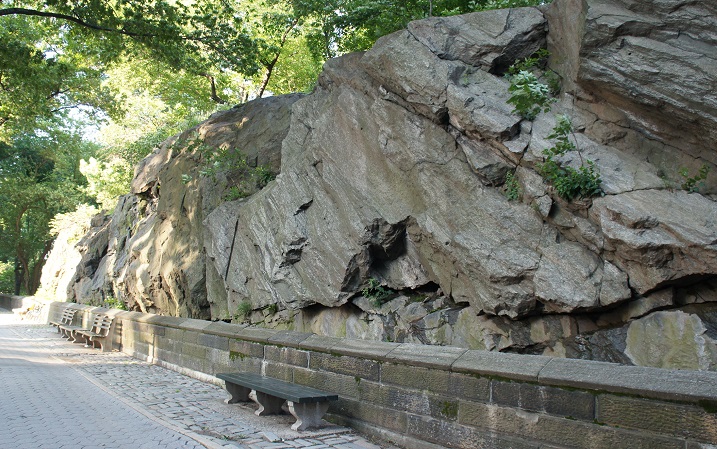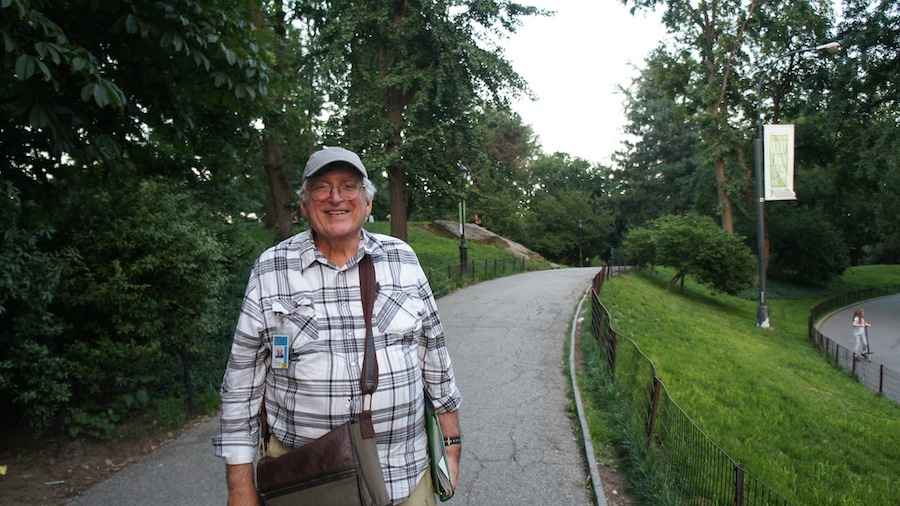Lost in Central Park? Rocks Guide the Way

NEW YORK — When the constellations are dulled by city lights, lowly rocks can be your lodestars if ever you get lost in Central Park.
"All you do is look for the tilt of the rocks," says geologist Sidney Horenstein. "They're always dipping in a southerly direction."
Horenstein, an environment educator emeritus at the American Museum of Natural History here, gives a handful of walking tours in the city each year. One such tour earlier this summer began just outside the museum, on the east side of Central Park West, between 82nd and 83rd streets, facing a dense cross-section of Manhattan schist, where the layers of hardened sediment are, indeed, tipped to the south. [See Photos of Central Park's Geology]
But it wasn't humans who put the rocks in that configuration.
It's an irksome but persistent myth that Central Park is entirely artificial. True, its creation story is filled with impressive feats of human engineering — 10 million cubic yards (7.6 million cubic meters) of topsoil were moved from New Jersey to replace New York's own contaminated dirt — but the public park is also one of the rare places in the city where ancient bedrock mingles with modern life.
Today, those often-hidden rock layers make a fine foundation for the city's skyscrapers. The durable Manhattan schist that runs down the island's spine got its start about 450 million years ago as soft mud on an ancient seafloor, Horenstein explains. The sediments, compressed into metamorphic rock, were folded and forced to the surface by continental collisions, perhaps getting their southerly tilt during these plate pileups or as the Atlantic Ocean opened up 100 million years ago, Horenstein said.
Geological quirks
Sign up for the Live Science daily newsletter now
Get the world’s most fascinating discoveries delivered straight to your inbox.
Central Park's geological quirks are often manifested on a less-than-tectonic scale, and they're everywhere — if you know where to look. For the uninitiated, seeing the park through Horenstein's eyes might be a slightly absurd experience.
"Finally, here's a glacial erratic," he says when we get to a smooth rock about the size of a turkey. It's nondescript to the untrained eye, except for the plaque fixed to it: "In loving memory of Nathan Brodsky 2007."
Horenstein explained that during the last ice age glaciers scraped over Manhattan's bedrock, leaving grooves and striations on the otherwise smooth surfaces in Central Park. As those vast sheets of ice plowed across the landscape, they also dragged and dropped a breadcrumb trail of rocks, today known as glacial erratics. The import in front of us came from the Palisades, New Jersey's cliffs along the Hudson River.
As we approach the Great Lawn, Horenstein stops the tour to behold a quaint building that's been repurposed as a public bathroom next to the Delacorte Theater, where a line is beginning to form for the night's performance of Shakespeare in the Park. Horenstein says to look at the window surroundings, cut from Indiana limestone, rock that formed at the bottom of tropical shallow seas that covered the Midwestern state some 330 million years ago. With a discerning eye, or perhaps a hand lens, one can see tiny fossilized traces of gastropods, and other miniscule ancient sea creatures, locked in the stone next to the janitor's closet.
A later stop is to look up at Cleopatra's Needle, the Egyptian obelisk near the Metropolitan Museum of Art and the oldest manmade object in Central Park. The towering monument, which has been in New York since 1881, was originally erected under Thutmose III around 1500 B.C. in the ancient city of Heliopolis. But for Horenstein, the story starts some 600 million years earlier, when the obelisk's raw material, Aswan granite, was formed from cooling magma. He points out the bronze crabs, barely visible from the ground, tucked into the broken corners of the obelisk, which are inscribed with the story of its journey.

Human stories behind the park
Perhaps geologists get a bad rap for being obsessed with all things inanimate, but Horenstein is brimming with more stories about people than he can possibly cram into a two-hour tour. He often halts the group, saying, "Oh, wait a minute," to thumb through a binder full of laminated maps, diagrams and photocopies that illustrate his point, but reminds us, "It's a long story," lamenting that he can't possibly get to it all.
At Summit Rock, the highest natural elevation in the park at 141.8 feet (43.2 meters), Horenstein lingers over a bit of lore about the American sculptor Sally James Farnham. As the story goes, Farnham in 1901 was bedridden with illness and depressed over the death of her father. In an attempt to coax her out of her despondent state, her husband, a jewelry and silver designer at Tiffany and Co., gave her modeling clay to play with. Farnham's talent for sculpting quickly became apparent, and she turned her hobby into a profession. By 1916, the sculptor's once-doting husband had deserted her and their children to chase get-rich-quick schemes out West, but Farnham's career was taking off. That year, she won a commission to replace a statue of Simón Bolívar in Central Park that New Yorkers had considered an eyesore since it was erected in the 1880s.
"It was so gross," Horenstein says. "Everyone hated it."
In 1921, Farnham's far-more-beloved version of the Venezuelan general, considered her masterpiece, had been installed at the very place the tour group was standing. Her statue has since been moved to the southern end of the park, but as Horenstein says, "There's another story about that."
Follow Megan Gannon on Twitter and Google+. Follow us @livescience, Facebook & Google+. Original article on LiveScience.











